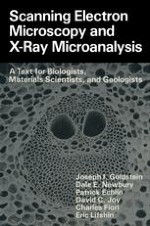1981 | OriginalPaper | Chapter
Electron-Beam-Specimen Interactions
Authors : Joseph I. Goldstein, Dale E. Newbury, Patrick Echlin, David C. Joy, Charles Fiori, Eric Lifshin
Published in: Scanning Electron Microscopy and X-Ray Microanalysis
Publisher: Springer US
Included in: Professional Book Archive
Activate our intelligent search to find suitable subject content or patents.
Select sections of text to find matching patents with Artificial Intelligence. powered by
Select sections of text to find additional relevant content using AI-assisted search. powered by
The versatility of the scanning electron microscope for the study of solids is derived in large measure from the rich variety of interactions which the beam electrons undergo within the specimen. The interactions can be generally divided into two classes: (1) elastic events, which affect the trajectories of the beam electrons within the specimen without significantly altering the energy, and (2) inelastic events, which result in a transfer of energy to the solid, leading to the generation of secondary electrons, Auger electrons, characteristic and continuum x-rays, long-wavelength electromagnetic radiation in the visible, ultraviolet, and infrared regions, electron-hole pairs, lattice vibrations (phonons), and electron oscillations (plasmons). In principle, all of these interactions can be used to derive information about the nature of the specimen—shape, composition, crystal structure, electronic structure, internal electric or magnetic fields, etc. To obtain this information from the signals measured and the images recorded with the SEM, the microscopist needs a working knowledge of electronspecimen interactions, broadly qualitative and where possible, quantitative. This chapter does not provide an in-depth treatment of electron physics; rather, it attempts to provide an overview necessary for the analysis of SEM images and compositionally related signals. Additional detail will be given in later chapters devoted to qualitative and quantitative x-ray microanalysis.
